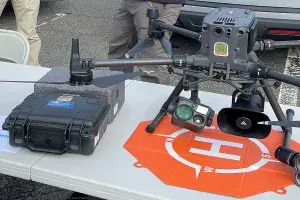 This drone was on display at a child safety fair in Enfield, Connecticut. (Photo by Steve Blindbury)
This drone was on display at a child safety fair in Enfield, Connecticut. (Photo by Steve Blindbury)
What once was mainly used by the military is now a recreational sport for many people, and with the early start of the holiday shopping season, they’re starting to fly off store shelves.
Today 8% of Americans own drones, according to Drone Survey Services, and in the last year, 63% of drone registrations with the Federal Aviation Administration (FAA) were for recreation, while 37% were for commercial operations.
Drones are super popular today, but they can create a tremendous hazard to our nation’s aviation system, and TSA is partnering with the FAA and local and state agencies to provide drone safety awareness to the public.

TSA’s Law Enforcement/Federal Air Marshal Service (LE/FAMS) teamed up with the FAA and the Connecticut State Police Drone Unit to meet kids and their families at a child safety fair at the Enfield Mall in Enfield, Connecticut. The mall’s parking lot is near Bradley International Airport, a perfect location for a drone safety outreach event.
“Drones are readily available to anyone at most retail outlets, and there is a general lack of knowledge on the regulations pertaining to their operation,” said TSA Connecticut Assistant Federal Security Director for Law Enforcement Steve Blindbury. “TSA addresses this challenge by partnering with other federal, state and local agencies to engage with the public at events such as safety fairs.”
Of course, the kids were fascinated by the cool drones on display.
“Many shoppers with their children saw a helicopter, heavy equipment and fire trucks set up; they saw drone demonstrations and came to see what was going on,” Blindbury said.
Through TSA’s outreach efforts, like the child safety fair, Blindbury hopes recreational drone flyers understand the dangers drones can pose to planes. Not many drone pilots realize height warnings are built into their unmanned aerial systems (UAS), which are very important safety precautions, especially when you’re flying drones near an airport.

“The general cap on UAS flights is 400 feet, although this gets lower and lower the closer you get to an airport,” Blindbury noted. “This is because they need to ensure that a drone does not cross into the flight path of commercial aircraft coming in for a landing or taking off. Additionally, we have had some drone pilots go as high as 10,000 feet to get video of the clouds. This presents the possibility of drones unintentionally crossing into national airspace.”
In Connecticut, TSA partnered with the State Police Aviation, Counter Drone Units to develop an incident response strategy. That includes quick responses to hunt down drones that might be flown in a nefarious manner, track them back to their pilots on the ground and apprehend suspected operators.
For their efforts, TSA Connecticut’s UAS team earned the 2022 TSA “Blogger Bob” Award, which recognizes an employee or team who positively influences public engagement by identifying, crafting, promoting and implementing creative solutions that significantly impact the traveling public’s views and interactions with TSA.
“We want every drone pilot to know that a drone is an aircraft, and there are rules for safe operation and becoming certified in their use,” Blindbury emphasized. “Reckless, negligent operation of a drone or intentionally disregarding the regulations can have serious consequences.”
Related story: TSA, FAA bring drone awareness to Connecticut high school
By Don Wagner, Strategic Communications & Public Affairs
